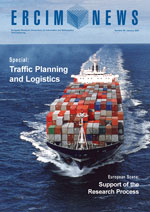by Jo van Nunen
The ambition of the European Union is to take a leading position in the world economy. Crucial to the business processes that can bring such prosperity to European citizens are sustainable transport and logistics systems. Successfully developing such systems requires a balance between the three 'Ps' of sustainability – Planet, People and Profit. This is not easy, since transportation has a number of negative consequences, including congestion and undesirable emissions. In this issue of ERCIM News, scientists in the field of traffic management, transport and logistics demonstrate how mathematical modelling can help to find the right balance between the 3 'Ps' while creating a sustainable future for the transport and logistics sector. The role of information technology is also discussed, since it is increasingly important in providing the infrastructure for monitoring traffic and logistics systems, for handling collected information and for providing the algorithms and methods necessary to analyse the large amounts of data that are now available.

First, consider the possibilities of using different devices for sensing logistic flows. Passive RFID-tags (radio frequency identification tags) mounted on cargo allow the flow of goods to be measured every time the cargo passes an RFID reading device. By using active RFID tags combined with GPRS devices, cargo flows can even be followed continuously. The information stored in the tag typically includes the type of product, the producer, the planned destination, the consignee and so on. During the transport process this information can be used to optimize the flow of goods, for security controls by customs at transshipment points and for sorting goods with similar destinations into combined shipments. This allows safe and secure flows to be created within designated trade lanes, and for the flows to be designed in such a way as to minimize environmental impacts.
If the cargo can be monitored on a real-time basis, additional opportunities to improve logistics processes become possible. Providing subsequent parties in the supply chain with advance information on the progress of a logistical process enables those parties to optimally plan their operations. In this issue several examples are discussed, varying from tracking and tracing of information to collaborative navigation solutions. If we extend the definition of logistics to include the production phase at the front end of the chain coupled with the treatment of the products after they are used, we enter the field of reverse logistics and closed-loop supply chains. Research in this area focuses on the possibilities of reusing, refurbishing, remanufacturing and recycling products and materials in a sustainable way. European research is at the forefront of this field and offers many opportunities for new economic activity. Reverse logistics research is based on the concept that "there is no waste, all products and materials are resources", something that fits well with the European value system.
Closed-loop supply networks, in which products and carriers can be monitored over their complete lifetime leads to the concept of installed base management. Cars, copiers, computers and machines, as well as objects such as tyres or lamps, can be monitored in real time. Processes such as repair and reuse can be triggered by the actual status of the installed product, which could even lead to a control shift "from tracking and tracing to sensing and pacing". As a consequence of this, work is needed on the phenomena of demand-driven and distributed control. Often virtual agent-based approaches can be used for this type of application. Within logistics research we are therefore seeing a shift from the solution of planning problems to online control approaches for which new models must be developed.
The problem of monitoring the flow of goods has many similarities to the monitoring of traffic and passenger flows. Personal mobile phones enable interactions between users of traffic infrastructure. Navigation systems with two-way communication, already common in truck transport, will be introduced for passenger transport. This will enable us to design intelligent transport systems that provide users with customized route selection choices in order to capture their preferred balance between Planet, People and Profit. Road-pricing and rewards for avoiding rush hour peaks can be dynamically incorporated in these customized systems. The models used in these cases incorporate multiple criteria in making decisions.
The navigation systems of the near future will use real-time information on road congestion based on mobile phone information from telecom operators. Using this information effectively requires that new methods be developed in order to forecast congestion, and research continues into advanced statistics-based methods for these types of applications. Further innovations in portable navigation systems will allow multi-modal transport solutions to be constructed, incorporating bike, bus, train and/or taxi in one trip and allowing users to select sustainable solutions to meet their needs.
At an aggregated level, the use of real-time information from all users of the infrastructure will lead to new forms of dynamic traffic management.
It is a challenge for us as researchers in this innovative field to contribute to these developments. In this issue of ERCIM News, you will read about a wide range of responses to this challenge.
Links:
http://www.euro-online.org/
http://www.rsm.nl/department1
Please contact:
Jo van Nunen
RSM Erasmus University Rotterdam, The Netherlands
E-mail: jnunen![]() rsm.nl
rsm.nl









